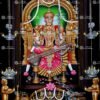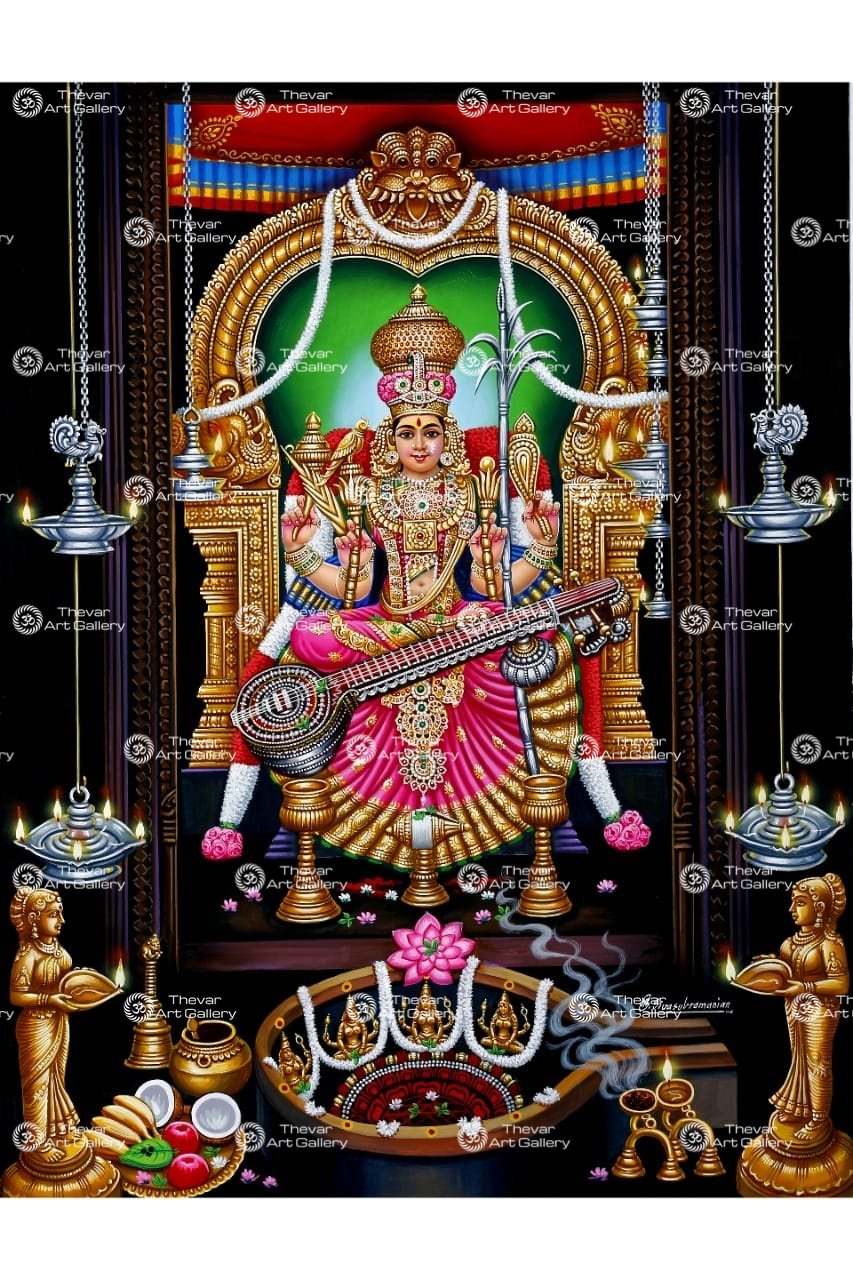- Empty cart.
- Continue Shopping
Kanchi Kamakshi Amman
Original price was: ₹ 2,000.00.₹ 1,299.00Current price is: ₹ 1,299.00.
Artist : Sivasubramanian
Size : 13*19 inches
Note:
- The Image shown in website is Print
- If the entered Pin code shows as not serviceable, don’t worry we will self ship your order
Out of stock
Kamakshi Amman Temple Kanjipuram : Kamatchi Amman
(Thanks : Source From Wikipedia)
The Kamakshi Temple is an ancient Hindu Temple dedicated to Kamakshi, the ultimate Goddess Lalita Maha Tripura sundari. It is located in the historic city of Kanchipuram, near Chennai, India. The Temple was most probably built by the Pallava kings, whose capital was Kanchipuram.
Pallava kings
The Image of the main Deity, Kamakshi, is seated in a majestic Padmasana, a yogic posture signifying peace and prosperity. Instead of the traditional standing pose. Goddess holds a sugarcane bow and bunch of five flowers in the lower two of her arms and has a pasha (lasso), an ankusha (goad) in her upper two arms.
There is also a parrot perched near the flower bunch. There are no other Goddess temples in the city of Kanchipuram, apart from this temple,. Which is unusual in a traditional city that has hundreds of traditional temples. There are various legends that account for this fact. Kamatchi Amman
Legend
As per Hindu legend, Kamakshi Amman is considered in line with Meenakshi at Madurai and Visalakshi at Varanasi. Kamakshi is the only Shakti shrine centered across all Shiva temples in Kanchipuram . Which do not have separate shrines for Amman. Kamakshi is worshipped thus as Parabrahma Swaroopini. She is none other than Lalitha Maha Tripura Sundari herself.
Architecture : Kamatchi Amman temple
The temple occupies an area of 5 acres (2.0 ha). The sanctum houses the image of Kamakshi in seated posture and is flanked by the trinity of Shiva, Vishnu and Brahma. There are smaller shrines of Bangaru Kamakshi, Adi Shankara and Maha Saraswathi around the sanctum.
Everyday the temple rituals start with Go Pooja and Gaja Pooja. There is a separate shed with Elephants,. Which performs pooja to the deity by trumpeting every day early morning 5.AM. In front of the Grabagraha there is a Gayatri Mandapam. to the right of the shire.We can see the deities arupa lakshmi, swaropa lakshmi. The temple is maintained and administered by Govt of TN.
The Devi in Adi Kamakshi temple which is close by the present Kamakshi temple, is called by various names like Kirtimati, Devagarbha in extant. Tantric works like Tantrachudamani. She has four hands containing in each of them respectively, Ankusa, Pasa, Abhaya and a Kapala. This description corresponds to those extant old tantric works.
Festivals : Kamatchi Amman temple
Four worship services are offered each day. The annual festival falls in Spring, in the Tamil month of Masi, which runs from mid-February to mid-March. During this time . The chariot festival (Ther) and float festival, (Theppam) are held.[1] Other festivals include Navaratri, Aadi and Aippasi Pooram, Sankara Jayanthi and Vasanta Utsavam in the Tamil month of Vaikasi.
All Fridays are considered sacred, though the Fridays in the Tamil months of . Adi (mid-July to mid-August) and Thai (mid-January to mid-February) are celebrated.
Kamakshi as Lalitha Maha Tripura Sundari
Shri Lalita Parabhattarika presides over the Kamakoshtha in five forms: Kamatchi Amman
Shri Kamakshi Para Bhattarika – Sri Kamakshi is the mula devata of the Kamakoti Peetha seated. In the centre of the inner sanctorum of the shrine in Kanchipuram known as the Gayatri mantapam. According to kamakshi rahasya, this mandapa was built by the celestials with the four walls representing the four Vedas and the twenty-four . Pillars representing the twenty-four syllables of the sacred formula of gayatri.
Shrividya Parameshvari,
who forms the inner core of the prakata gayatri and. thus called rahasya gayatrI, is enshrined at the centre of the gayatri mandapam as Shri Kamakshi. She is seated on pancha brahmasana and. Sports in her four hands pasha, ankusha, iskhu kodanda and pushpa bana. Paramba is seated in yonyasana and faces southeast.
When tormented by asuras led by Bhandasura, devas are said to have performed. A penance to appease the Supreme Shakti in the form of parrots, residing on champaka vrkshas at Kanchi. Pleased with their penance, Paramba is said . To have appeared from her residence in Mahameru or Bilakasha through the bila dvara and destroyed the demons.
The shri vigraha of Paramba
-Has been described as representing. Her three forms: sthula (Dhyana yogya, Savayava), Sukshma (mantra and yantratmaka) and Karana or Vasanatmaka. It is also said that Lord Mahadeva himself worshipped paramba in the four yugas assuming the forms of sages krodha bhattaraka, parashurama, . Dhaumya and Adi shankara bhagavatpada (and muka shankara, believed to be an incarnation of krodha bhattaraka).
Bila dvara leading to bilakasha can be seen today in front . Of the tapomagna kamakshI sannidhi inside the garbhagrha. It is also said that bhagavan rudra assumed the form of durvasas on her. Emergence from the bilakasha and first worshipped her through the modalities of shrividya tantra by consecrating a shrichakra. He is thus the sampradaya guru of shrividya and the credit for crystallizing paramba at Kanchipuram as Gurumurtisvarupini
The forms of vashinyadi Vagdevatas can be seen around. The Shrichakra in their same positions as in Shripura. A shrine dedicated to hayagrIva and agastya can be seen in the . Third prakara of the temple, at the location where the teaching of Lalita Trishati was imparted.Kamatchi Amman
Tapah Kamakshi
– This form of paramba can be seen to the right of the mula devata and close to the bila dvara. Separated from mahadeva, uma appeared first as annapurna in Kashi. And then following the advice of sage Katyayana, appeared in Kanchi to worship Ekamranatha under the mango tree in rudrakoshtha and married him.
Anjana Kamakshi
– Also known as Arupa , her shrine is situated to the left of the mula devata, facing the north and in front of saubhagya ganapati.
Rama is said to have performed a penance to regain her lost beauty. In this place and due to the grace of paramba, kumkuma offerings of mula devata is offered to her here before being accepted by the devotees. While she represents Rama in her form as rama-bija, she represents Kamakshi in the form of Kamakalakshara that is inherent in the rama bIja.
Svarna Kamakshi
– The shrine of this deity, also known as Bangaru. Kamakshi is situated in the second prakara. It is said that this form was created by Shrividya parameshvari from her third. Eye to serve as the shakti of ekamranatha named ekambika.
The original idol that appeared from the third-eye of. Paramba is seen today in Tanjore, which was transported to Tanjore to protect the idol from Muslim attacks by Kamakshidasa, an ancestor of Shri Shyama Shastrigal.
Utsava Kamakshi
– The shrine of Utasava Kamakshi, the idol which is brought . Out during processions, is located in the second prakara. The idol is accompanied on either side by idols of Sharada and Rama. While the devatas generally are accompanied by their male/female consorts in most cases, On account of Kamakshi being Shiva-shaktyatmika, there is no shrine devoted to Shiva here.
Sri Lalitambika, who appeared from Chidagni for the destruction of Bhandasura, . Was presented to the world by Brahma with the special name – Sri Kamakshi. Thus, ‘Kamakshi’ is the special epithet of the . Primordial Parashakti Sri Lalita. As she brings joy to the mind of Sri Kameshwara, she is referred to as ‘Sri Lalita’.
Durvasa Maharishi : Kamatchi Amman Temple
Kamakshi Amman Temple with the golden overlays over its gopurams.
- The shrine situated in front of Sri Kamakshi’s Garbha Grham is of Sage Durvasas, also known as Krodha Bhattaraka. There are thirty-two chief upasakas of Devi like manu, chandra, kubera etc. Among these, Kamaraja, Lopamudra and Durvasa are the chief upasakas. Durvasa pranita vidya is called Sadi vidya. Durvasa represents the power of sattvika krodha of Amba, used to protect and correct her devotees, and her limitless kriya shakti.
- It is Sri Durvasa who established the Kamakoti Peetha by consecrating a Bhu-Prastara Srichakra in front of Amba. He composed Lalita Stavaratna, also called Arya dwisahti, describing the Srinagara. He also composed Traipura Mahimna Stotra, a complete mantra shastra in itself and also . The Para Shambhu Mahimna Stotra. Due to a curse by Saraswati,
- he was born as a deaf and dumb brahmana and was graced by Sri Kamakshi with Anugraha Diksha.
Misconception of Raudra Swaroopa
Another popular myth is about Adi Shankara pacifying the Raudra Swarupa of Kamakshi. Sri Kamakshi is Purna Brahma Swarupini and she did not attain Raudra. The shrine in the temple premises, referred to as Adi Kamakshi, is actually Kalikamba. It is possible that this deity was pacified by Adi Acharya
- The Kanchi Kamakshi Amman Temple as a Shakti Peeth
- Main articles: Daksha Yaga and Shakti Peethas
- Shiva carrying the corpse of Sati (goddess)
- The mythology of Daksha yaga and Sati’s self-immolation is the main theme in the origin of Shakti Peethas.
- Shakti Peethas are divine temples of Adiparashakti. The cause of the presence of Devi’s presence is due to the falling of body parts of the corpse of Sati Devi. The naval part of Sati Devi’s body is believed to have fallen here. There are 51 Shakti Peeth linking to the 51 alphabets in Sanskrit. There are also arguments that the old Kanchi temple is the Shakti peetha, where Sankaracharya has installed the Shri Chakra.
Tirukkalvanur : Kamatchi Amman Temple
In the shrine of Kamakshi Amman close to the sanctum, the Tirukalavanur Divya Desam, the temples dedicated to Vishnu in his form of Varaha glorified by the 7th-10th century alwars (Tamil saint poets) is present. The temple faced west went to ruins and the deity is now placed inside the Kamakshi Amman temple. There are shrines over the vimana.
| Weight | 1 kg |
|---|---|
| Dimensions | 200 × 50 × 200 mm |














